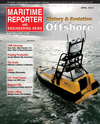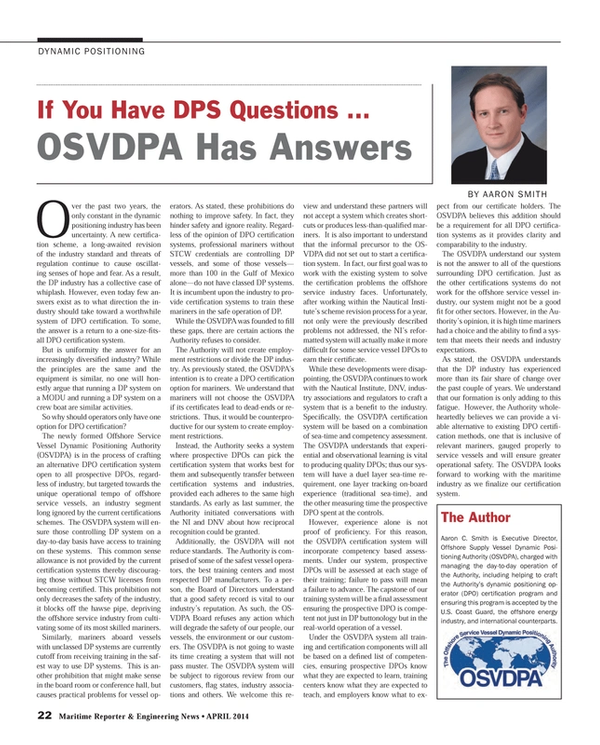
If You Have DPS Questions ... OSVDPA Has Answers
Over the past two years, the only constant in the dynamic positioning industry has been uncertainty. A new certification scheme, a long-awaited revision of the industry standard and threats of regulation continue to cause oscillating senses of hope and fear. As a result, the DP industry has a collective case of whiplash. However, even today few answers exist as to what direction the industry should take toward a worthwhile system of DPO certification. To some, the answer is a return to a one-size-fits-all DPO certification system.
But is uniformity the answer for an increasingly diversified industry? While the principles are the same and the equipment is similar, no one will honestly argue that running a DP system on a MODU and running a DP system on a crew boat are similar activities.
So why should operators only have one option for DPO certification?
The newly formed Offshore Service Vessel Dynamic Positioning Authority (OSVDPA) is in the process of crafting an alternative DPO certification system open to all prospective DPOs, regardless of industry, but targeted towards the unique operational tempo of offshore service vessels, an industry segment long ignored by the current certifications schemes. The OSVDPA system will ensure those controlling DP system on a day-to-day basis have access to training on these systems. This common sense allowance is not provided by the current certification systems thereby discouraging those without STCW licenses from becoming certified. This prohibition not only decreases the safety of the industry, it blocks off the hawse pipe, depriving the offshore service industry from cultivating some of its most skilled mariners.
Similarly, mariners aboard vessels with unclassed DP systems are currently cutoff from receiving training in the safest way to use DP systems. This is another prohibition that might make sense in the board room or conference hall, but causes practical problems for vessel operators. As stated, these prohibitions do nothing to improve safety. In fact, they hinder safety and ignore reality. Regardless of the opinion of DPO certification systems, professional mariners without STCW credentials are controlling DP vessels, and some of those vessels—more than 100 in the Gulf of Mexico alone—do not have classed DP systems. It is incumbent upon the industry to provide certification systems to train these mariners in the safe operation of DP.
While the OSVDPA was founded to fill these gaps, there are certain actions the Authority refuses to consider.
The Authority will not create employment restrictions or divide the DP industry. As previously stated, the OSVDPA’s intention is to create a DPO certification option for mariners. We understand that mariners will not choose the OSVDPA if its certificates lead to dead-ends or restrictions. Thus, it would be counterproductive for our system to create employment restrictions.
Instead, the Authority seeks a system where prospective DPOs can pick the certification system that works best for them and subsequently transfer between certification systems and industries, provided each adheres to the same high standards. As early as last summer, the Authority initiated conversations with the NI and DNV about how reciprocal recognition could be granted.
Additionally, the OSVDPA will not reduce standards. The Authority is comprised of some of the safest vessel operators, the best training centers and most respected DP manufacturers. To a person, the Board of Directors understand that a good safety record is vital to our industry’s reputation. As such, the OSVDPA Board refuses any action which will degrade the safety of our people, our vessels, the environment or our customers. The OSVDPA is not going to waste its time creating a system that will not pass muster. The OSVDPA system will be subject to rigorous review from our customers, flag states, industry associations and others. We welcome this review and understand these partners will not accept a system which creates short-cuts or produces less-than-qualified mariners. It is also important to understand that the informal precursor to the OSVDPA did not set out to start a certification system. In fact, our first goal was to work with the existing system to solve the certification problems the offshore service industry faces. Unfortunately, after working within the Nautical Institute’s scheme revision process for a year, not only were the previously described problems not addressed, the NI’s reformatted system will actually make it more difficult for some service vessel DPOs to earn their certificate.
While these developments were disappointing, the OSVDPA continues to work with the Nautical Institute, DNV, industry associations and regulators to craft a system that is a benefit to the industry. Specifically, the OSVDPA certification system will be based on a combination of sea-time and competency assessment. The OSVDPA understands that experiential and observational learning is vital to producing quality DPOs; thus our system will have a duel layer sea-time requirement, one layer tracking on-board experience (traditional sea-time), and the other measuring time the prospective DPO spent at the controls.
However, experience alone is not proof of proficiency. For this reason, the OSVDPA certification system will incorporate competency based assessments. Under our system, prospective DPOs will be assessed at each stage of their training; failure to pass will mean a failure to advance. The capstone of our training system will be a final assessment ensuring the prospective DPO is competent not just in DP buttonology but in the real-world operation of a vessel.
Under the OSVDPA system all training and certification components will all be based on a defined list of competencies, ensuring prospective DPOs know what they are expected to learn, training centers know what they are expected to teach, and employers know what to expect from our certificate holders. The OSVDPA believes this addition should be a requirement for all DPO certification systems as it provides clarity and comparability to the industry.
The OSVDPA understand our system is not the answer to all of the questions surrounding DPO certification. Just as the other certifications systems do not work for the offshore service vessel industry, our system might not be a good fit for other sectors. However, in the Authority’s opinion, it is high time mariners had a choice and the ability to find a system that meets their needs and industry expectations.
As stated, the OSVDPA understands that the DP industry has experienced more than its fair share of change over the past couple of years. We understand that our formation is only adding to this fatigue. However, the Authority wholeheartedly believes we can provide a viable alternative to existing DPO certification methods, one that is inclusive of relevant mariners, gauged properly to service vessels and will ensure greater operational safety. The OSVDPA looks forward to working with the maritime industry as we finalize our certification system.
The Author
Aaron C. Smith is Executive Director, Offshore Supply Vessel Dynamic Positioning Authority (OSVDPA), charged with managing the day-to-day operation of the Authority, including helping to craft the Authority’s dynamic positioning operator (DPO) certification program and ensuring this program is accepted by the U.S. Coast Guard, the offshore energy industry, and international counterparts.
(As published in the April 2014 edition of Maritime Reporter & Engineering News - http://magazines.marinelink.com/Magazines/MaritimeReporter)
Read If You Have DPS Questions ... OSVDPA Has Answers in Pdf, Flash or Html5 edition of April 2014 Maritime Reporter
Other stories from April 2014 issue
Content
- Offshore: Seacor Raises the Bar Again page: 13
- Offshore Service Vessels Design Innovation page: 14
- U.S. Coast Guard Doing Less with Less page: 18
- New Conept Under Test: Arctic Drillship page: 20
- If You Have DPS Questions ... OSVDPA Has Answers page: 22
- How to Work with Your Insurer When Experiencing a Loss page: 24
- Calculating Settlement Value of a Case page: 26
- Strategic Planning With Aggregate Data page: 30
- Is Internal Combustion Engine Methane Slip Harmful to the Environment? page: 32
- Floating Production Growth May Face Obstacles page: 38
- Arctic Energy Exploration Efforts Heat Up page: 44
- Saipem: A Fleet Grows in Brazil page: 50
- Inside Paraguay’s Oil Boom page: 54
- The History of Offshore Energy page: 56
- Offshore Energy Timeline:1806-2014 page: 56
- C-MAR's Modern Approach to DP Training in Brazil page: 64
- CNR: Innovation Maintains US Naval Advantages page: 66
- STEM: SeaPerch Underwater Robotic Championships page: 72
- Safety the Focus as Heavy Lifting Picks Up page: 78
- Cool Runnings: R.W. Fernstrum's Engineered Solutions page: 82
- Rosie the Riveter: WWII Women Shipyard Workers Visit the White House page: 88
- Modern Solutions Power Systems Conference page: 91
- ABS Approves Design for GTTNA’s LNG Bunker Barge page: 92
- Rolls-Royce Wins Heyerdahl Award page: 94
- Damen Opens JV Yard in Vietnam page: 95
- BASS Launches New Fleet Management System page: 96
- Shipboard Pipe-joining Techniques Examined page: 98
- Luxury Yachts: Design Takes a New Track page: 100
- New Air Regulator from TDI page: 103
- DNV GL ShipManager for Entire H&P Fleet page: 103
- FARO Debuts X Series Laser Scanner page: 103
- Jinglu Chooses AVEVA Design Software page: 103
- Macro Sensors Gauge Tank Volume Changes page: 103
- Special Coupling Solution for Offshore Drives page: 103
- Conquest Offshore Buys Star Software page: 103
- Eniram Launches New Optimization Product for LNG Sector page: 104
- COSCO Selects Rolls-Royce Package page: 104
- New Tests for Ballast Water Contamination page: 104
- SSI Debuts Updated ShipConstructor page: 104
- Wärtsilä’s Launches Inline Scrubber System page: 104
- New Transas Liquid Cargo Handling Simulator page: 104
- New Hull Structure Analysis Software page: 104
- GEA Westfalia Separator Launches New Control Generation page: 105
- Omega Debuts Compact RTD Temperature Sensors page: 105
- New Heavy Duty CNC Plasma System page: 105
- Wärtsilä Introduces 46DF Dual Fuel Engine page: 105
- WSS Achieves Better Onboard Air Quality page: 105
- Trojan Marinex BWT System Earns IMO Type Approval page: 106


